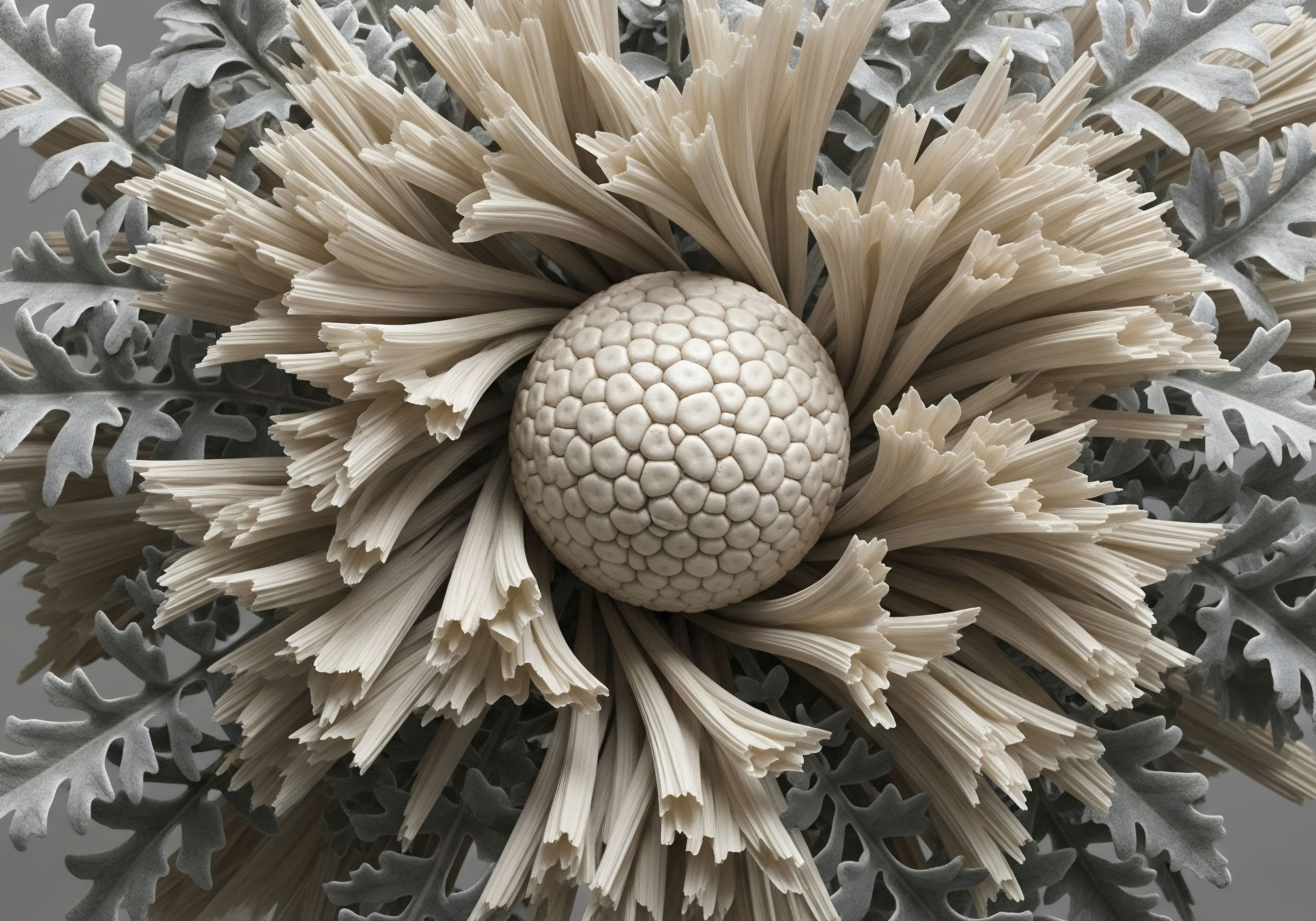

Fundamentals
The persistent ache, the lingering stiffness, the feeling that your body simply isn’t recovering as it once did ∞ these are not merely physical sensations. They are signals, a quiet conversation your biological systems are attempting to have with you, often unheard amidst the noise of daily life.
Many individuals experience a profound sense of frustration when conventional approaches to injury rehabilitation yield only partial or temporary relief. This experience can feel isolating, as if your body has somehow betrayed its innate capacity for repair. Understanding these deep-seated concerns is the first step toward reclaiming your vitality.
Our bodies possess an extraordinary ability to heal, a complex symphony orchestrated by countless biological messengers. When an injury occurs, whether from acute trauma or repetitive strain, a cascade of events initiates. Inflammation, while often perceived negatively, serves as an initial, vital response, clearing damaged tissue and signaling for repair cells.
Following this, the body mobilizes resources to rebuild, laying down new collagen and regenerating cellular structures. Yet, for many, this intricate process seems to falter, leading to chronic discomfort or impaired function.
A significant, yet frequently overlooked, aspect of this healing equation lies within the delicate balance of our internal chemical messengers. The endocrine system, a network of glands and organs, produces hormones that act as the body’s conductors, orchestrating a symphony of cellular responses. When their rhythm falters, the entire performance suffers.
These chemical signals influence everything from tissue regeneration and protein synthesis to inflammation modulation and pain perception. A suboptimal hormonal environment can significantly impede the body’s capacity for robust repair, turning what should be a temporary setback into a prolonged struggle.
Understanding the body’s internal chemical messengers is paramount for effective injury recovery and restoring full function.
Consider the foundational role of various hormones in maintaining tissue integrity and driving repair. Growth hormone, for instance, plays a central role in cellular regeneration, collagen synthesis, and the repair of connective tissues. Its natural production can decline with age, potentially slowing recovery rates.
Similarly, testosterone, often associated with muscle mass, also contributes significantly to bone density, collagen synthesis, and overall tissue repair mechanisms in both men and women. Imbalances in these core hormones can create a systemic environment less conducive to optimal healing.

The Body’s Repair Mechanisms
At a cellular level, injury repair involves a coordinated effort of various cell types and signaling pathways. Fibroblasts, chondrocytes, and osteoblasts are among the specialized cells responsible for synthesizing the extracellular matrix components that form new tissue. These cells respond to a complex array of growth factors, cytokines, and hormones.
A robust healing response requires adequate nutrient supply, efficient waste removal, and precise communication between cells. When this communication is disrupted, or the necessary building blocks are scarce, the repair process becomes inefficient.

How Hormones Influence Tissue Regeneration?
Hormones act as crucial regulators in the complex process of tissue regeneration. For example, insulin-like growth factor 1 (IGF-1), stimulated by growth hormone, mediates many of growth hormone’s anabolic effects, including protein synthesis and cellular proliferation. Thyroid hormones influence metabolic rate and protein turnover, both vital for tissue repair.
Even cortisol, often seen as a stress hormone, plays a role in modulating inflammation, though chronic elevation can suppress healing. A comprehensive view of injury recovery must therefore extend beyond the immediate site of damage to encompass the systemic biochemical environment.
Peptides, smaller chains of amino acids, represent a fascinating frontier in supporting the body’s intrinsic healing capabilities. Unlike larger protein molecules, peptides often act as highly specific signaling molecules, interacting with particular receptors to elicit targeted biological responses. Some peptides can mimic or enhance the actions of naturally occurring growth factors, while others may directly influence inflammatory pathways or cellular repair processes. Their targeted nature allows for a more precise intervention, potentially optimizing the healing cascade without broad systemic effects.


Intermediate
Moving beyond the foundational understanding of the body’s healing architecture, we now consider how specific peptide protocols can be strategically employed to support recovery from various injury types. The concept here is not a one-size-fits-all solution, but rather a tailored approach that respects the unique biological demands of different tissues and the individual’s overall endocrine landscape.
This personalized strategy aims to optimize the internal environment, allowing the body to perform its repair functions with greater efficiency and completeness.
Peptides function as precise biological communicators, guiding cellular behavior. Imagine the body as a vast, intricate communication network. Hormones are the broad broadcast signals, influencing many different receivers simultaneously. Peptides, conversely, are like highly specific text messages, sent to particular cell types or receptors, eliciting a very targeted response. This specificity makes them compelling candidates for addressing the precise needs of injured tissues.

Targeted Peptide Protocols for Injury Support
The application of peptide protocols for injury support is grounded in their ability to modulate key physiological processes involved in tissue repair. These processes include inflammation resolution, cellular proliferation, angiogenesis (new blood vessel formation), and collagen synthesis. Different peptides exhibit distinct mechanisms of action, making certain compounds more suitable for particular injury types or phases of healing.

Peptides for Tissue Repair and Regeneration
One prominent peptide in the realm of tissue repair is Pentadeca Arginate (PDA). This compound is gaining recognition for its potential in accelerating tissue repair, reducing inflammation, and supporting overall healing. PDA’s mechanism of action involves modulating cellular signaling pathways that are critical for tissue regeneration. It appears to influence the migration and proliferation of cells essential for wound healing, such as fibroblasts, which are responsible for synthesizing collagen and other extracellular matrix components.
Other peptides frequently discussed in the context of injury recovery include BPC-157 and TB-500. While not explicitly listed in the core pillars, their mechanisms align with the principles of tissue repair. BPC-157, a partial sequence of body protection compound, has been studied for its regenerative effects on various tissues, including muscle, tendon, ligament, and bone.
It is thought to promote angiogenesis and modulate growth factor expression. TB-500, a synthetic version of thymosin beta-4, plays a role in cell migration, actin regulation, and tissue repair, particularly in soft tissues.
Peptides offer a precise way to support the body’s natural healing processes by targeting specific cellular pathways.
The tailoring of these protocols depends on the specific injury. For a tendon or ligament injury, where collagen synthesis and structural integrity are paramount, peptides that promote fibroblast activity and collagen cross-linking would be prioritized. For muscle tears, compounds that support satellite cell activation and protein synthesis would be more relevant. Bone fractures might benefit from peptides that enhance osteoblast activity and calcium deposition.

Integrating Peptides with Hormonal Optimization
The efficacy of peptide protocols can be significantly enhanced when integrated within a broader framework of hormonal optimization. The body’s endocrine system provides the foundational environment for all cellular processes, including repair. A robust hormonal profile ensures that the signals peptides send are received and acted upon effectively.
Consider the role of Growth Hormone Peptide Therapy. Peptides such as Sermorelin, Ipamorelin / CJC-1295, Tesamorelin, and Hexarelin stimulate the body’s natural production of growth hormone. Increased endogenous growth hormone levels can provide a systemic anabolic environment, supporting not only muscle gain and fat loss but also accelerating tissue repair and recovery from injuries. This systemic support complements the localized action of specific repair peptides.
For men experiencing symptoms of low testosterone, Testosterone Replacement Therapy (TRT) can be a crucial component of a comprehensive recovery strategy. Weekly intramuscular injections of Testosterone Cypionate, often combined with Gonadorelin to maintain natural production and fertility, and Anastrozole to manage estrogen conversion, create an optimal hormonal milieu. Testosterone directly influences protein synthesis, bone density, and the overall anabolic state, which are all critical for effective injury healing.
Similarly, for women, Testosterone Replacement Therapy, typically with lower doses of Testosterone Cypionate or Pellet Therapy, alongside Progesterone when appropriate, addresses hormonal imbalances that can impede recovery. Balanced female hormones contribute to bone health, connective tissue integrity, and a healthy inflammatory response, all vital for robust healing.
The synergy between peptide therapy and hormonal optimization is clear. Peptides provide targeted signals for repair, while a balanced endocrine system ensures the body has the systemic resources and responsiveness to act on those signals. This dual approach creates a powerful strategy for accelerating recovery and restoring function.
The specific tailoring of peptide protocols for injury types often involves a careful assessment of the individual’s overall health, hormonal status, and the nature of the injury. This assessment guides the selection of peptides, their dosages, and the duration of the protocol.
| Peptide Category | Primary Mechanism | Typical Injury Applications |
|---|---|---|
| Tissue Repair Peptides (e.g. PDA, BPC-157, TB-500) | Promotes cellular proliferation, angiogenesis, collagen synthesis, modulates inflammation | Tendonitis, ligament sprains, muscle tears, bone fractures, chronic wounds |
| Growth Hormone Secretagogues (e.g. Sermorelin, Ipamorelin) | Stimulates endogenous growth hormone release, systemic anabolic effects | Overall recovery, anti-aging, muscle repair, fat loss, sleep improvement, general tissue regeneration |
| Sexual Health Peptides (e.g. PT-141) | Activates melanocortin receptors, influences sexual arousal | Erectile dysfunction, female sexual dysfunction (indirectly supports overall well-being which aids recovery) |
A structured approach to peptide therapy for injury involves several considerations:
- Injury Type and Severity ∞ Acute injuries may benefit from immediate intervention to reduce inflammation and initiate repair, while chronic injuries might require longer protocols focused on remodeling and strengthening.
- Individual Hormonal Status ∞ Baseline hormone levels (testosterone, growth hormone, thyroid hormones) significantly influence the body’s capacity to respond to peptide signals. Addressing deficiencies here is paramount.
- Systemic Health Factors ∞ Nutritional status, sleep quality, stress levels, and metabolic health all play a role in recovery. Peptides work best in a body that is otherwise well-supported.
- Specific Peptide Selection ∞ Choosing the right peptide or combination of peptides based on their known mechanisms of action and the specific tissue involved.
- Dosage and Administration ∞ Determining appropriate dosages and routes of administration (e.g. subcutaneous injections) for optimal effect and safety.
The goal is to create a harmonious internal environment where the body’s natural healing intelligence can operate unimpeded, supported by targeted biochemical signals. This integrated perspective moves beyond simply treating symptoms, addressing the underlying physiological mechanisms that govern true recovery.


Academic
The sophisticated interplay between peptide signaling and the broader endocrine system represents a frontier in optimizing human physiology, particularly in the context of tissue repair and regeneration. To truly grasp how peptide protocols can be precisely tailored for specific injury types, one must delve into the intricate molecular and cellular mechanisms that govern healing, recognizing the profound influence of systemic hormonal balance. This academic exploration moves beyond simple descriptions, examining the deep endocrinology and systems biology that underpin effective therapeutic strategies.
Tissue repair is a highly regulated biological process involving distinct phases ∞ inflammation, proliferation, and remodeling. Each phase is characterized by the sequential activation of specific cell types, growth factors, cytokines, and extracellular matrix components. The efficiency and completeness of this cascade are profoundly influenced by the systemic hormonal milieu. A disruption in this delicate balance, often seen with aging or chronic stress, can lead to impaired healing, fibrosis, or chronic pain states.

Endocrine Regulation of Tissue Homeostasis and Repair
The endocrine system acts as the master regulator of cellular metabolism and growth, exerting its influence through a complex network of feedback loops. The Hypothalamic-Pituitary-Gonadal (HPG) axis and the Hypothalamic-Pituitary-Adrenal (HPA) axis are particularly relevant. The HPG axis, controlling sex hormone production, directly impacts protein synthesis, collagen integrity, and bone mineral density.
For instance, testosterone and estrogen receptors are present in various connective tissues, and these hormones modulate fibroblast activity and extracellular matrix turnover. Declining levels of these hormones, as seen in andropause or menopause, can compromise tissue resilience and regenerative capacity.
The HPA axis, governing the stress response, releases cortisol, which at physiological levels, helps resolve inflammation. However, chronic elevation of cortisol, often due to persistent stress or injury, can become catabolic, suppressing protein synthesis, impairing immune function, and inhibiting fibroblast proliferation, thereby hindering repair. Understanding this delicate balance is critical for designing effective interventions.
The body’s ability to heal is profoundly influenced by the intricate balance of its hormonal and cellular communication systems.
Growth hormone (GH) and its downstream mediator, Insulin-like Growth Factor 1 (IGF-1), are central to anabolic processes. GH stimulates IGF-1 production primarily in the liver, and IGF-1 then mediates many of GH’s effects on cell growth, differentiation, and protein synthesis.
In the context of injury, GH and IGF-1 promote collagen deposition, accelerate wound closure, and support the regeneration of muscle, bone, and cartilage. Peptide secretagogues like Sermorelin and Ipamorelin work by stimulating the pituitary gland to release more endogenous GH, thereby amplifying this crucial anabolic pathway.

Molecular Mechanisms of Peptide Action in Injury
Peptides, as signaling molecules, exert their effects by binding to specific receptors on cell surfaces, initiating intracellular signaling cascades. The specificity of these interactions allows for highly targeted therapeutic interventions.
Consider Pentadeca Arginate (PDA), a peptide designed to support tissue repair. Research indicates PDA influences pathways related to cell migration, proliferation, and extracellular matrix remodeling. Its potential to modulate inflammatory cytokines and growth factor expression suggests a multi-pronged approach to healing. For instance, in models of soft tissue injury, PDA may enhance the recruitment of reparative cells to the injury site and promote the organized deposition of new collagen fibers, reducing scar tissue formation.
Another example is PT-141, a melanocortin receptor agonist. While primarily known for its role in sexual health, its mechanism of action highlights the broad reach of peptide signaling. By activating melanocortin receptors in the central nervous system, PT-141 influences neuroendocrine pathways. This underscores the interconnectedness of seemingly disparate biological systems; optimizing one aspect of physiological function can indirectly support overall well-being, which in turn contributes to a more robust healing environment.
The precision of peptide action allows for tailoring protocols based on the specific tissue injured and the desired physiological outcome.
- For Tendon and Ligament Injuries ∞ Protocols might emphasize peptides that stimulate fibroblast activity and collagen synthesis, such as PDA or those that enhance growth factor signaling. The goal is to improve the tensile strength and elasticity of the newly formed connective tissue.
- For Muscle Injuries ∞ Peptides that promote satellite cell activation, protein synthesis, and angiogenesis would be prioritized. This supports efficient muscle fiber regeneration and minimizes atrophy.
- For Bone Fractures ∞ Strategies would involve peptides that enhance osteoblast differentiation and activity, alongside systemic hormonal support (e.g. optimized testosterone and growth hormone levels) to ensure adequate calcium and phosphate deposition for robust callus formation.
- For Cartilage Damage ∞ Peptides that stimulate chondrocyte proliferation and extracellular matrix production, while also modulating inflammatory responses within the joint, are considered.

The Systems Biology Perspective on Peptide Integration
A truly sophisticated approach to peptide protocols for injury requires a systems-biology perspective. This means understanding that no single hormone or peptide acts in isolation. Instead, they operate within a complex web of interactions, influencing and being influenced by metabolic pathways, neurotransmitter function, and immune responses.
For example, chronic inflammation, often a component of persistent injuries, can dysregulate hormonal axes. Elevated inflammatory cytokines can suppress the HPG axis, leading to lower testosterone levels, which in turn impairs healing. Conversely, optimizing hormonal balance through targeted interventions like TRT can reduce systemic inflammation, creating a more favorable environment for peptide action.
Metabolic health also plays a critical role. Insulin resistance, for instance, can impair cellular nutrient uptake and reduce the effectiveness of anabolic signals, including those from growth hormone and peptides. Addressing underlying metabolic dysfunction through lifestyle interventions and, if necessary, targeted pharmaceutical support, can significantly enhance the body’s responsiveness to peptide therapy.
The concept of personalized wellness protocols extends to the precise titration of peptide dosages and combinations. This is not a static prescription but a dynamic process, adjusted based on objective markers (e.g. lab results for hormone levels, inflammatory markers) and subjective patient experience (symptom resolution, functional improvement).
| Hormone/Peptide | Primary Role in Healing | Synergistic Peptide/Hormone | Clinical Relevance for Injury |
|---|---|---|---|
| Testosterone | Protein synthesis, bone density, collagen integrity, anti-inflammatory | Growth Hormone Peptides, PDA | Muscle repair, bone fractures, connective tissue strength |
| Growth Hormone/IGF-1 | Cellular regeneration, collagen synthesis, wound healing, anabolism | Sermorelin, Ipamorelin, Tesamorelin | Overall tissue repair, anti-aging, recovery from extensive injuries |
| Pentadeca Arginate (PDA) | Cell migration, proliferation, inflammation modulation, matrix remodeling | Optimized Testosterone, Growth Hormone | Targeted repair of tendons, ligaments, muscles, chronic wounds |
| Progesterone | Anti-inflammatory, neuroprotective, bone health (in women) | Testosterone (women’s protocols) | Connective tissue health, neurological recovery post-injury |
The rigorous application of peptide protocols, informed by a deep understanding of endocrinology and systems biology, allows for a truly individualized approach to injury recovery. This strategy moves beyond symptomatic relief, aiming to restore the body’s intrinsic capacity for robust, complete healing, thereby reclaiming full function and vitality. The precision offered by peptides, when combined with a foundation of hormonal balance, represents a powerful tool in the pursuit of optimal health and longevity.

References
- Boron, Walter F. and Emile L. Boulpaep. Medical Physiology ∞ A Cellular and Molecular Approach. Elsevier, 2017.
- Guyton, Arthur C. and John E. Hall. Textbook of Medical Physiology. Elsevier, 2020.
- Krzysik, Robert, and Małgorzata Podolak. “Testosterone and its role in tissue repair and regeneration.” Postępy Higieny i Medycyny Doświadczalnej 72 (2018) ∞ 610-620.
- Sigalos, George, and Dimitrios G. Koutkia. “Growth Hormone and IGF-1 in Tissue Repair.” Growth Hormone & IGF Research 24, no. 4 (2014) ∞ 135-141.
- The Endocrine Society. Clinical Practice Guidelines. Various publications on hypogonadism, menopause, and growth hormone deficiency.
- Walker, Robert F. “Growth hormone-releasing peptides ∞ an emerging class of therapeutics.” Clinical Interventions in Aging 2, no. 2 (2007) ∞ 231-236.
- Zhu, W. et al. “BPC 157 promotes tendon healing in rats.” Journal of Orthopaedic Research 32, no. 11 (2014) ∞ 1432-1439.
- Gao, Y. et al. “Thymosin beta 4 promotes wound healing in diabetic mice.” Wound Repair and Regeneration 23, no. 1 (2015) ∞ 101-109.

Reflection
The journey toward reclaiming your body’s full potential after an injury is deeply personal, often marked by moments of frustration and profound discovery. The insights shared here, from the intricate dance of hormones to the precise signals of peptides, are not simply academic concepts. They represent a framework for understanding your own biological systems, offering a pathway to not just recover, but to truly optimize your vitality.
Consider this knowledge a compass, guiding you through the complex terrain of your own physiology. The path to sustained well-being is rarely linear; it requires curiosity, patience, and a willingness to explore beyond conventional boundaries. Recognizing the profound connection between your hormonal balance, metabolic function, and the body’s capacity for repair is a powerful realization.
This exploration serves as an invitation to engage more deeply with your own health narrative. What signals is your body sending? How might a more harmonized internal environment unlock greater resilience and function? The answers lie within a personalized approach, one that honors your unique biological blueprint and empowers you to move forward with renewed strength and confidence.



